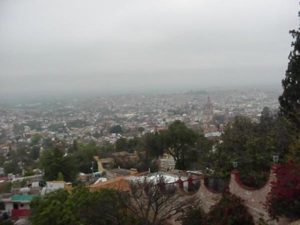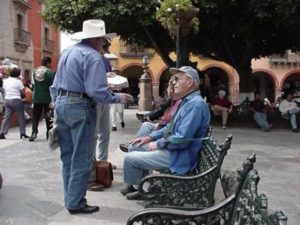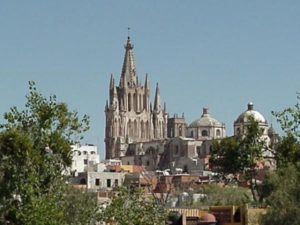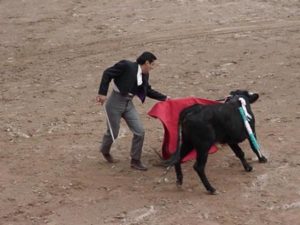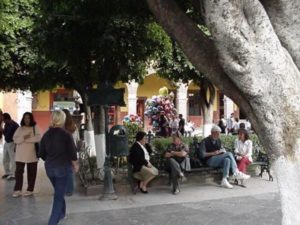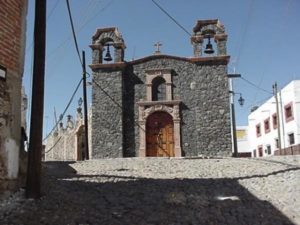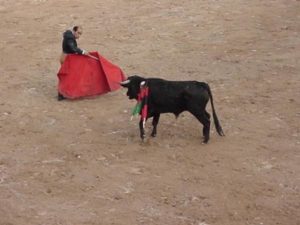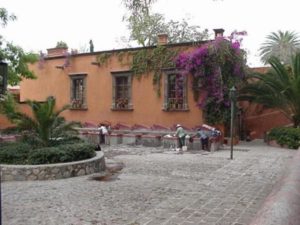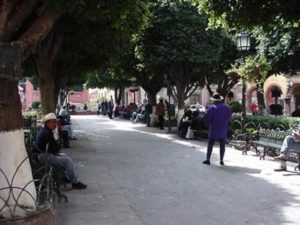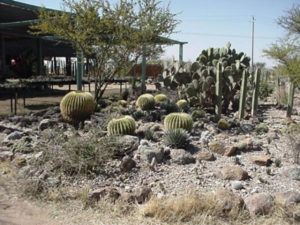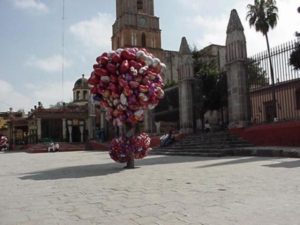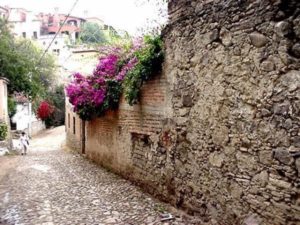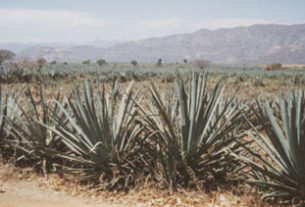We woke to the sound of gunshots – six in rapid succession. My husband levitated off the bed shouting “What! What was that?” The shots continued, punctuated by long black silence between them.
Eventually we braved getting out of bed and peeking out the window. Behind the brick wall of a nearby church courtyard, we saw illuminating fireworks in bursts of color and sound. In the distance, in all directions, church bells began to ring. Welcome to San Miguel de Allende. It would be our home for the next three months.
From the Heartland of Iowa to the heart of Mexico, we two snowbirds flew in search of a warmer perch to spend winter and, hopefully, to catch a glimpse of the lives and traditions of magical Mexico.
The colonial gem of San Miguel is nestled in the mountainous central region of Mexico. Local legend has it that the town was begun by a barefoot Franciscan monk in 1542 named Fray Juan de San Miguel.
It was a charming, albeit, backwater town with little to attract travelers, until after World War II. Then, in the late1940s, two schools for the Arts were formed – The Belles Artes and the Institute de Allende. Throngs of GIs discovered their post war education grants stretched much further in Mexico than in the USA, and thus began the establishment of a relatively large expatriate population that exists today.
The traveler and long term residents alike contribute greatly to the local economy , but at the price of taking away from the traditions and the privacy that are revered by every Mexican. However, if resentment exists today, it is well hidden. Daily, I have been taken with how gentle and friendly the local people are toward two aging gringos from Iowa.
In recent years San Miguel has gained popularity with travelers. Last year it made the “Top Places to Retire To” list in AARP‘s Modern Maturity magazine. Also, word of mouth is causing San Miguel’s popularity to soar. Travelers arrive, year round, to enjoy the “eternal spring” climate. The clear light of San Miguel draws artists from around the world to paint the colorful colonial buildings draped in bright bougainvillea.
With so much to see and to do, one can never be bored. Most of the historical homes and churches are clustered near the Jardin, the main square and heart of the city. One of our favorite activities this winter has been to simply sit in the Jardin and watch life happen around us. It is the daily gathering place for visitors and locals alike, and the center from where the many city celebrations begin and end. Life here is celebrated with gusto and latino passion that seems watered down in my own Midwestern melting pot. Fireworks, such as those that welcomed us to San Miguel, are often a part of the celebration as are many balloons and flowers.
The Parroquia, a huge pink cathedral across from the Jardin, was originally built in 1680 as a simple structure. Local legend has it, that the ornate facade and towering pinnacles were designed by an indigenous stonemason some 200 years later. He drew a picture in the sand with a stick, copying from a European postcard and directed his workers from the drawing. But, the Parroquia is only one of the many beautiful colonial churches and historical homes in San Miguel.
One way to take in most of the highlights is to take the walking tour that leaves from the front of the square. You’ll have a lively walk about town and hear the history and folklore of most of the buildings. A mere five blocks away from the city center you’ll find the Plaza de Toros – a 5,000 seat bullfight ring where on any given weekend while Iowans cheer on the Hawk Eyes, folks here root for the young matadors. I, on the other hand, cheer for the bull.
Although buses and taxis are plentiful, you’ll find San Miguel is best experienced on foot. One site not to be missed as you walk about town is El Chorro, where the women gather to scrub laundry and enjoy each others’ company just as they have done for hundreds of years. If you continue walking uphill from El Chorro, you’ll eventually arrive t at tha Mirador for a fantastic overview of picturesque San Miguel below.
For the more serious trekker, there are the Botanical Gardens just on the edge of town where you can hike over rustic cactus lined trails and enjoy the natural raw beauty of the surrounding desert..
Long known for its promotion of the Arts, San Miguel has two major schools, The Bellas Artes and The Institute de Allende, offering courses year round in everything from Batik to Wood Cut. Both schools also offer frequent traditional concerts and other performing arts. Language schools also abound here, offering the opportunity to learn, or improve, your Spanish. There are a plethora of galleries to enjoy and every week, it seems the opening of yet another.
The library or, Biblioteca Publica, is the center for many activities and has a fair selection of reading material in both Spanish and English. You can sign up for a conversation partner any afternoon and practice your Spanish. Upstairs the newly opened Computer Center allows you to keep in touch with friends and family via the Internet. Enjoy a leisurely cup of coffee and a pastry in the Santa Ana Cafe, right in the library, or take in one of the foreign films or lectures in the small theater. Late afternoon brings throngs of children to do their homework, at tables scattered about the open courtyard in the center of the library.
Although our opportunities and activities have been many, what we have most enjoyed this past three months in San Miguel, has been to simply sit in a corner of the Jardin and observe life passing by in the square. A young mother and son feed the pigeons. Whole committees of aging gringos solve world problems from a park bench. A woman serves up cooked corn on the cob smeared with mayonnaise and cheese along with a cheerful “Buenos Dias”. A young couple intertwines under the shade of an Indian Laurel tree sharing the secrets of young love. Across the street, bells of the Parroquia begin to ring rich and sonorous, and we know, deep in our bones, how very lucky we are to have spent this winter in San Miguel de Allende lost in the tranquility and consistency of tradition of timeless Mexico.

